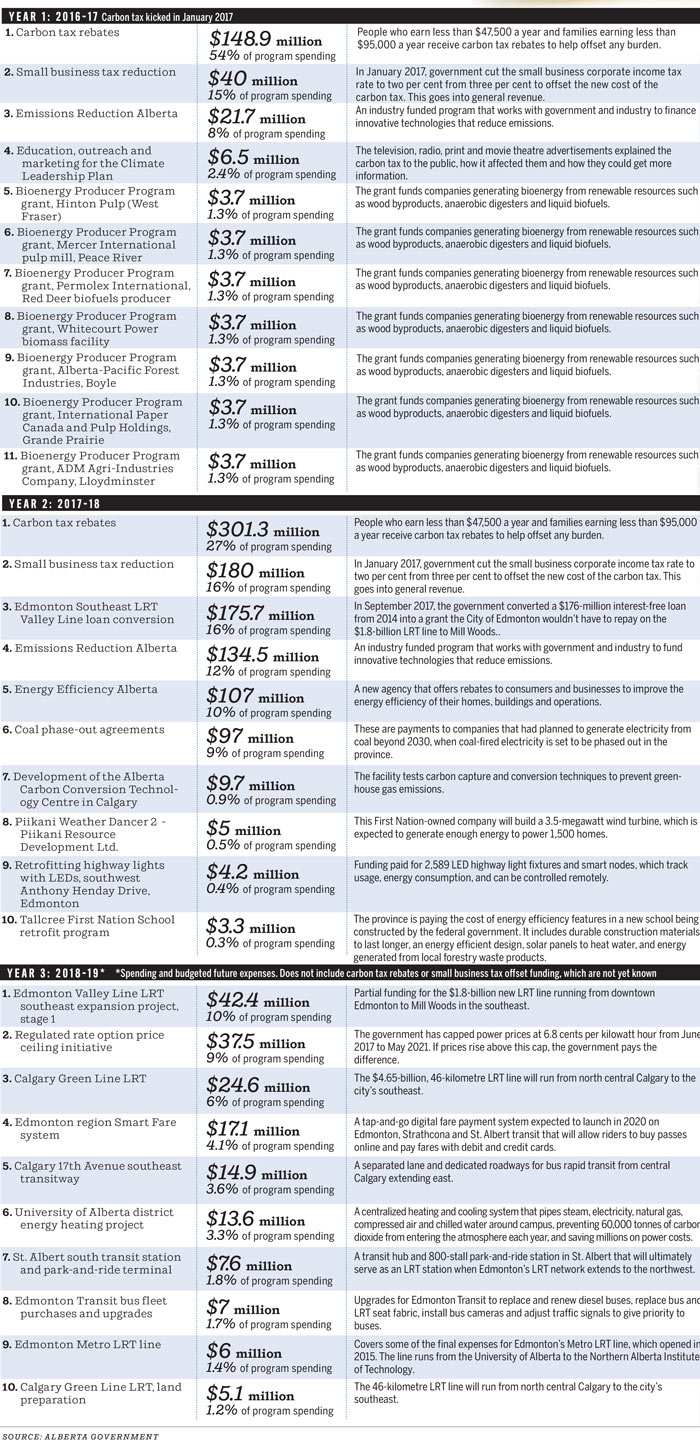This timeline of events shows how Alberta adopted a carbon tax and how the policies in the Climate Leadership Plan were developed and rolled out.
Janet French - Edmonton Journal - Updated: March 6, 2019
October 2002: The Progressive Conservative government released its first emissions reductions plan, Albertans and Climate Change: Taking Action. The plan set a goal of reducing carbon emissions 50 per cent by 2020, which would be 10 per cent below 1990 levels in the province.
November 2003: The Climate Change and Emissions Management Act passed in the legislature, putting the emissions targets into law.
July 1, 2007: Amended legislation and new regulations required facilities emitting more than 100,000 tonnes of carbon per year to reduce their emissions by 12 per cent. Companies that failed to reach that emissions target paid $15 a tonne into a new climate change fund. Critics in heavy industry called it a carbon tax.
January 2008: The PC government released a second plan, Alberta’s 2008 Climate Change Strategy, which relied heavily on conservation efforts and carbon capture technology to reduce emissions. It set goals short of the Kyoto Protocol targets the federal government had committed to.
February 2009: The arm’s-length Climate Change and Emissions Management Corporation was formed to decide how best to spend the millions of dollars paid by companies whose emissions exceeded provincial limits. The money was invested in green energy production, conservation and energy efficiency and carbon capture projects.
April 19, 2015: The Alberta NDP released its election platform. It promised to phase out coal-fired electricity in the province and expand sources of renewable energy. It vowed to end investment in carbon capture and storage experiments and reinvest the funding into public transit. It pledged to strengthen environmental standards and monitoring, and create energy efficiency and renewable energy strategies.
May 5, 2015: Albertans voted in the Alberta NDP, toppling 44 years of Conservative rule in Alberta.
June 25, 2015: Environment and Parks Minister Shannon Phillips announced changes to the 2007 Specified Gas Emitters Regulation, signalling her intentions to raise the price of carbon emissions during the next two years. Phillips also appointed University of Alberta energy economics Prof. Andrew Leach chairman to an advisory panel to review the province’s climate change policies and hold public consultations.

July 22, 2015: The NDP government reneged on a campaign promise to end funding to carbon capture projects, and said it would continue to fund two projects.
Aug. 14, 2015: Phillips named four other people to the Climate Change Advisory Panel, including industry and environmental representatives.
Oct. 19 2015: Justin Trudeau’s Liberals, who promised to impose a federal price on carbon where provinces have not, were elected to form a majority federal government.
RELATED
- Alberta carbon tax: The province’s most kicked political football
- A look at where the money has been spent
- How six Alberta communities spent green money
- Crunching the carbon tax data: How we did it
- Alberta’s had a carbon tax on big emitters for a decade focused on funding research
- Indigenous communities clamour for climate dollars to improve life on reserve
- When energy-efficient light bulbs got political in Alberta

Nov. 22, 2015: Premier Rachel Notley and Phillips unveiled the details of the Climate Leadership Plan in Edmonton. The plan would phase out coal emissions by 2030, regulate electricity prices and invest in renewable energy. It set a goal to produce 30 per cent of Alberta’s power from renewable sources by 2030. Government said it would also cap oilsands carbon emissions at 100 megatonnes a year.
This is also where the NDP introduced its plan for an economy-wide carbon tax that would see consumers pay new levies at gas pumps and on home heating. The tax was set at $20 per tonne of carbon dioxide emissions as of Jan. 1, 2017, and rose to $30 per tonne on Jan. 1, 2018. The revenue would be used for rebates for low-to-middle income Albertans, a percentage point cut in the small business tax and investment in public transit and clean energy research.
May 24, 2016: The Climate Leadership Implementation Act was introduced in the legislature. It came into force on June 13, 2016.
July 6, 2016: Federal Conservative MP Jason Kenney announced he would campaign to unite right-wing parties in Alberta and critiqued the NDP’s climate plan and carbon tax.
Sept. 9, 2016: Kenney said in a speech to the Economic Club of Canada’s Calgary branch he would scrap the carbon tax if elected premier.
Oct. 3, 2016: Prime Minister Justin Trudeau announced the federal government will introduce a $10-per-tonne carbon tax in provinces without a price on carbon, rising to $50 a tonne by 2022.

October 2016: The Climate Change and Emissions Management Corporation was rebranded as Emissions Reduction Alberta.
Oct. 27, 2016: Energy Efficiency Alberta was created. The arm’s-length body runs consumer rebate programs, hands out free and low-cost energy efficient products and offers incentives for commercial operations to invest in efficiency.
Nov. 22, 2016: The provincial government announced sweeping changes to the regulation of the province’s electricity market and a new cap on consumer electricity prices.
Dec. 14, 2016: The Oilsands Emissions Limit Act came into force capping carbon emissions at 100 megatonnes per year. Regulations have yet to be written.
Jan. 1, 2017: Alberta’s economy-wide carbon tax took effect setting the price at $20 per tonne of carbon dioxide emissions.
Jan. 17, 2017: Phillips unveiled a new program giving consumers free or low-cost light bulbs and low-flow shower heads.
Oct. 28, 2017: Kenney was elected leader of the United Conservative Party.
Jan. 1, 2018: Alberta’s carbon tax rose to $30 per tonne of carbon dioxide emissions.
Spring 2019: An Alberta provincial election is expected.


